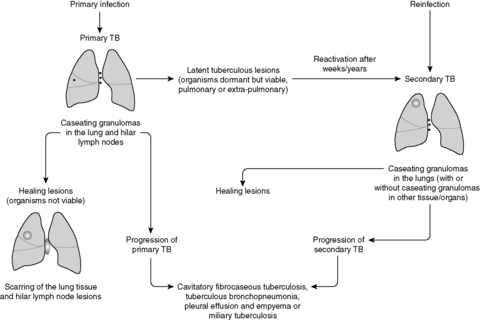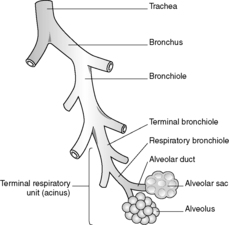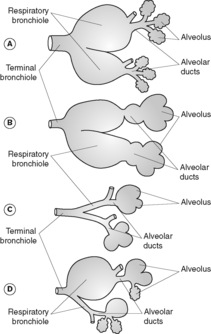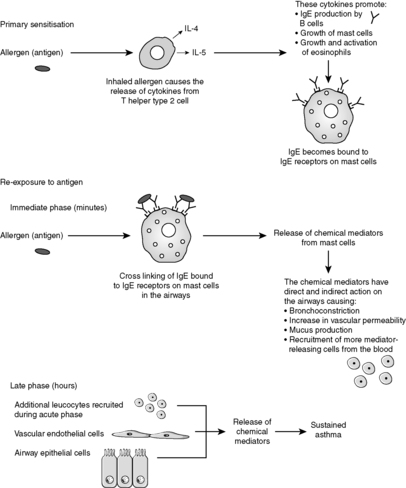Nasal passages and paranasal sinuses135
15.2 The larynx136
15.3 The lungs136
The respiratory system extends from the nasal orifices to the periphery of the lungs and the pleura, and includes the nasal passages, paranasal sinuses, larynx and lungs. The pathology of these structures will be discussed in this chapter. Respiratory diseases are so common that you will inevitably encounter them in whichever branch of medicine you decide to follow. Many bed-ridden patients develop some degree of bronchopneumonia. Pneumonia is also a frequent cause of hospital admission, and is often fatal in the elderly and infirm. Obstructive and restrictive (interstitial) lung diseases are common, causing significant morbidity among the general population. Last but not least, lung cancer is not only the most common malignancy in men, with increasing frequency in women, but it is also the most frequently fatal malignancy. Lung disease in general is a major cause of morbidity and mortality across the globe, and its importance in clinical practice cannot be overemphasised.
15.1. Nasal passages and paranasal sinuses
Structure and function
The nasal passages and sinuses lie in continuity and are lined by respiratory-type epithelium. The function of the nasal sinuses is to warm, humidify and clean inspired air.
Inflammatory disorders
Inflammatory diseases are the commonest disorders to affect the nasal passages and paranasal sinuses.
Rhinitis
Inflammation of the nasal passages has two main causes:
• The common cold (infective rhinitis). This is almost invariably initiated by a virus.
• Hay fever (allergic rhinitis). This is initiated by allergens, the inflammatory reaction being mediated via type I and type III hypersensitivity reactions (see Ch. 8).
Nasal polyps
These inflammatory swellings are common and result from recurrent inflammation of the nasal passages. They are often bilateral (in contrast with nasal tumours which are usually unilateral).
Sinusitis
Inflammation of the sinuses is frequently a complication of acute rhinitis. Swelling of the nasal mucosa obstructs the drainage orifices of the sinuses. This leads to stasis of the secretions within the sinuses, with consequent infection and inflammation.
Tumours
Tumours of the nasal passages and sinuses are uncommon.
Benign
The most frequent benign tumours are:
• squamous papilloma
• inverted papilloma (transitional cell papilloma)
• haemangioma
• angiofibroma.
Malignant
Malignant tumours of the nasal passages and paranasal sinuses include:
• squamous cell carcinoma
• transitional cell carcinoma
• adenocarcinoma
• plasmacytoma
• olfactory neuroblastoma.
15.2. The larynx
Structure and function
The larynx connects the trachea to the pharynx. It is a complex organ with numerous connective tissue elements. The lining epithelium varies from non-keratinising stratified squamous to respiratory-type epithelium. The function of the larynx is to allow air into the trachea and to produce sound for speaking. The epiglottis prevents food from entering the trachea.
Inflammatory disorders
Laryngitis
Inflammation of the larynx can be the result of infection, overuse of the voice, mechanical irritation or exposure to tobacco, other chemical agents, or allergens. Infective laryngitis can be caused by a number of viruses and bacteria. The laryngeal inflammation is usually mild, but if it is severe, such as in diphtheria, the resultant oedema and exudate can cause laryngeal obstruction, particularly in children.
Epiglottitis
The most commonly implicated organism in epiglottitis is the bacteria Haemophilus influenzae. Infection results in marked oedema and enlargement of the epiglottis, which can cause life-threatening airway obstruction in children.
Tumours
Benign
The commonest benign tumours are:
• laryngeal polyps (‘singers’ nodes’). These are most often found in smokers or people who overuse their larynx
• squamous papilloma.
Malignant
The most frequent malignant tumour of the larynx is squamous cell carcinoma, which typically affects males over 40. This tumour is associated with cigarette smoking, and there may be an increased risk in those exposed to asbestos. Arising most often on the vocal cords, the carcinoma invades locally and can later cause widespread distant metastases.
15.3. The lungs
You should:
• understand the structure and function of the lungs
• know the major groups of lung disorders
• know the various types of infective, obstructive, restrictive, vascular and neoplastic lung conditions
• understand the aetiology and pathogenesis of important respiratory diseases.
Structure and function of the lungs
The function of the lungs is to exchange gases between the inspired air and the blood. Inspired air passes from the trachea into the main left and right bronchi. Each bronchus then branches dichotomously giving rise to progressively smaller airways, hence the term ‘respiratory tree’ (Figure 36). Progressive branching of the bronchi forms bronchioles. Bronchioles branch until they form terminal bronchioles. The part of the lung distal to each terminal bronchiole is called the acinus, or terminal respiratory unit. Branching of the terminal bronchioles gives rise to respiratory bronchioles, which in turn branch into alveolar ducts. Each alveolar duct branches and empties into blind-ended alveolar sacs, where gas exchange occurs. A group of 3–5 acini is referred to as a lobule.
The trachea, bronchi and bronchioles are lined by respiratory-type epithelium. The alveoli are lined by type I and type II pneumocytes, beneath which lies a thin connective tissue membrane. This membrane separates the alveoli from the pulmonary capillaries but allows rapid and efficient diffusion of gases.
Inflammatory disorders
Bronchitis
Acute bronchitis can be caused by infection or exposure to irritant chemical agents such as tobacco smoke, sulphur dioxide and chlorine. Infective inflammation of the bronchi is usually accompanied by inflammation of the trachea and larynx (acute laryngotracheobronchitis), which is clinically more severe in children (‘croup’). Acute infective bronchitis is most commonly initiated by viruses such as respiratory syncytial virus (RSV), although bacteria can also be a cause. Episodes of acute bronchitis are often seen in people with chronic bronchitis, causing an exacerbation of the established disease.
Bronchiolitis
There are three main types of bronchiolitis:
• Primary bronchiolitis: This is most commonly seen in infants, in whom it can cause symptoms of acute respiratory distress. The inflammation is usually caused by viruses, especially RSV. Resolution is usual, but a minority of patients develop bronchopneumonia.
• Follicular bronchiolitis: This is seen in patients with rheumatoid arthritis. Lymphoid aggregates with germinal centres compress the airways.
• Bronchiolitis obliterans: This can occur from a number of diseases and disease states, and is characterised by the obliteration of bronchiolar lumina by masses of organising inflammatory exudate.
Bacterial pneumonia
Pneumonia is defined as an inflammatory condition of the lung characterised by consolidation (solidification) of the pulmonary tissue. In infective pneumonia, the causative organism infects the lung parenchyma, causing the formation of an inflammatory exudate within the alveolar spaces with consequent consolidation.
Pathogenesis
The respiratory system uses a number of defence mechanisms to clear or destroy any inhaled microorganisms.
These include:
• nasal secretions
• the mucociliary apparatus
• alveolar clearance by macrophages
• coughing and sneezing.
Pneumonia can result whenever these defence mechanisms are impaired (see Table 21).
| Defect in defence mechanism | Causes |
|---|---|
| Loss or suppression of the cough reflex | Coma, sedation, neuromuscular disorders, drugs |
| Impairment of ciliary function | Immotile cilia syndrome (Kartagener syndrome) |
| Injury to the mucociliary apparatus | Cigarette smoking |
| Accumulation of secretions | Cystic fibrosis, bronchiectasis |
| Interference with alveolar macrophage function | Cigarette smoking, hypoxia |
| Flooding of the alveoli | Pulmonary congestion and oedema |
| Reduction in immune response | Immunosuppression |
Classification
Classically, pneumonia is classified according to the main anatomical pattern of consolidation into bronchopneumonia and lobar pneumonia (Figure 37).
Bronchopneumonia Bronchopneumonia is characterised by patchy consolidation of the lung. Those individuals most at risk are elderly people, infants, and people with debilitating illnesses. Typical aetiological organisms include streptococci, staphylococci, pneumococci, H. influenzae, Pseudomonas aeruginosa and coliform bacteria. The consolidation is multilobular and frequently bilateral and basal. Histologically, a neutrophil-rich exudate fills the bronchi, bronchioles and adjacent alveolar spaces.
Lobar pneumonia Lobar pneumonia is characterised by consolidation of a large portion of a lobe or an entire lobe, and it typically affects otherwise healthy adults aged between 20 and 50years. The most common pathogenic organism is Streptococcus pneumoniae. Less common causal organisms are Klebsiella pneumoniae, staphylococci, streptococci and H. influenzae.
Atypical pneumonia
The term ‘atypical’ in the context of pneumonia is used when the inflammatory changes in the lungs are confined to the alveolar septa and interstitium, without a significant alveolar exudate. Characteristically, patients have few localising symptoms even with severe atypical pneumonia. As such, atypical pneumonia should be suspected when the chest X-ray findings are much worse than the symptoms.
Immunocompromised patients are particularly at risk.
Aetiology
In immunocompetent individuals, the causes of atypical pneumonia are:
• Viruses, e.g. influenza, RSV, adenovirus
• Bacteria, e.g. Legionella pneumophila (Legionnaire disease)
• Mycoplasma
• Coxiella burnetii (Q fever).
In immunocompromised individuals the causes of atypical pneumonia are:
• Viruses, e.g. CMV, measles, varicella
• Bacteria, e.g. Pneumocystis carinii, Chlamydia
• Fungi, e.g. Candida, Aspergillus.
Aspiration pneumonia
When food or liquid is aspirated into the lung, there is irritation of the pulmonary tissue by the acidic gastric contents and introduction of organisms from the oropharynx. Inflammation and consolidation of the affected part of the lung may ensue. At-risk clinical situations include sedation, coma, anaesthesia and acute alcoholism.
Lung abscess
A lung abscess is a local suppurative process within the lungs (often walled off), accompanied by necrosis of the lung tissue.
Aetiology and pathogenesis
Under the right conditions, almost any pathogen can cause a lung abscess. An abscess may form as a result of:
• Aspiration or bacterial pneumonia
• Entrapment of septic emboli in the lungs (e.g. embolisation of vegetations in infective endocarditis)
• Infection of a pulmonary infarct
• Airway obstruction. An abscess may form beyond the obstruction, which may be a tumour or a foreign body
• Miscellaneous situations, such as following penetrating trauma to the lung or the spread of infection from neighbouring organs.
Complications
With antibiotic therapy, many resolve and heal completely leaving a fibrous scar. A persistent abscess may require surgical treatment. Possible complications of a lung abscess include an empyema (pus in the pleural space), pyopneumothorax, haemorrhage and spread of infection to distant sites to cause, for example, brain abscesses or meningitis.
Tuberculosis
The term ‘tuberculosis’ refers to the disease caused by Mycobacterium tuberculosis (found within infected respiratory secretions and air droplets) and less commonly Mycobacterium bovis (found in the milk of diseased cows). Tuberculosis is the single most important infectious cause of death in the world. Up until the mid-1980s, Western countries had seen a decline in the number of clinical cases because of:
• improved hygiene and social conditions
• the introduction of effective antibiotics against the bacilli
• the introduction of immunisation with bacille Calmette–Guérin (BCG).
At present the incidence of tuberculosis is rising in the USA, Europe and Africa, most probably due to the increasing incidence of human immunodeficiency virus (HIV) infection. Furthermore, antibiotic-resistant strains are now being isolated. The lung is the commonest site for infection. Tuberculosis is classically divided into two phases, primary and post-primary (secondary) tuberculosis (Figure 38).
 |
| Figure 38 |
Primary tuberculosis
Inhaled M. tuberculosis passes into the lungs and initiates a non-specific inflammatory response. Alveolar macrophages phagocytose the organism and transport it to the hilar lymph nodes. These naive macrophages are unable to kill the organism, and so more macrophages are recruited. Meanwhile, the bacilli multiply, lyse the host cell and then infect more macrophages. At this point, the organisms can potentially disseminate via the bloodstream to other parts of the lung and more distant sites. In immunocompetent hosts, the mycobacteria activate the T cells, which can cause lysis of infected macrophages and stimulate macrophages to mature into epithelioid cells, which are effective killers of M. tuberculosis. Some epithelioid cells fuse to become multinucleated giant cells. Consequently, a granuloma forms consisting of epithelioid cells, giant cells and a central area of caseous necrosis corresponding to lysed infected macrophages (see Ch. 4). The bacilli are unable to survive in such acidic and oxygen-poor conditions, and so infection is controlled. A calcified scar forms in both the affected lung parenchyma (Ghon focus) and the hilar lymph nodes, which together are called the primary Ghon complex. Importantly, bacilli may still survive in these scarred foci for many years. Primary tuberculosis is asymptomatic in most cases. Rarely, particularly with infants, children or immunocompromised adults, the primary lesion may progress, resulting in cavitation, tuberculous bronchopneumonia, pleural effusion and empyema, or miliary tuberculosis (tuberculosis spreading around the body).
Miliary tuberculosis
If the tuberculous bacteraemia becomes heavy during primary or post-primary tuberculosis, miliary tuberculosis may result. Miliary tuberculosis is characterised by numerous granulomas in many organs, and may be fatal if left untreated.
Obstructive airways disease
This group of disorders is characterised by an increase in resistance to airflow, owing to partial or complete obstruction at any level of the respiratory tree. The major obstructive disorders are chronic bronchitis, emphysema, asthma and bronchiectasis. The symptom common to all these disorders is ‘dyspnoea’ (difficulty breathing), but each have their own clinical and anatomical characteristics.
Chronic bronchitis and emphysema almost always coexist, and the term chronic obstructive pulmonary disease (COPD) is often used to refer to them.
Chronic bronchitis
Aetiology
Undoubtedly, the single most important cause is cigarette smoking.
Pathogenesis
Irritants, such as tobacco smoke, cause two main abnormalities, which lead to airway obstruction.
• Increase in size (hypertrophy) of submucosal glands and a marked increase in the number (hyperplasia) of goblet cells. There is consequent hypersecretion of mucus, mainly in the large airways, which results in mucous plugging and overproduction of sputum.
• A respiratory bronchiolitis affecting the smaller airways of less than 2mm in diameter.
Infection does not seem to play a role in the initiation of chronic bronchitis, but is an important cause of exacerbations.
Emphysema
Emphysema is characterised by abnormal permanent dilatation of the air spaces distal to the terminal bronchioles, accompanied by destruction of their walls without obvious fibrosis. The clinical symptoms of emphysema do not appear until at least a third of the lung parenchyma is destroyed. Typically, patients overventilate to remain well oxygenated, and are then referred to as ‘pink puffers’.
Classification
Emphysema is classified into four main types according to the anatomical distribution of the lesions and based on the appearance of the lungs with the naked eye or hand lens (Figure 39).
Centrilobular (centriacinar) emphysema In this type there is involvement of the central or proximal parts of the acinus with sparing of the distal alveoli. The lesions are closely associated with cigarette smoking and are more common in the upper lobes.
Panlobular (panacinar) emphysema In this type all airways distal to the terminal bronchioles (i.e. the entire acinus) are involved. The lower lobes are more commonly affected, particularly the bases. Panacinar emphysema is associated with α1-antitrypsin deficiency.
Paraseptal emphysema In this type the distal (peripheral) part of the acinus is involved, with sparing of the proximal part. It is usually more severe in the upper lobes. The affected airways can become very dilated, forming cyst-like structures which are termed ‘bullae’ if they reach over 10mm in diameter. These bullae may rupture, resulting in a spontaneous pneumothorax.
Irregular emphysema In this type the acinus is irregularly involved. Irregular emphysema is almost invariably associated with scarring.
Pathogenesis
Current evidence indicates that emphysema is due to an imbalance between protease and antiprotease activity in the lung. Support for this theory is based on the association between α1-antitrypsin deficiency and the development of emphysema. α1-Antitrypsin inhibits the actions of proteases, particularly elastase, which is secreted by neutrophils. α1-Antitrypsin deficiency is a genetic disorder showing an autosomal recessive pattern of inheritance. Homozygous patients have reduced levels of the enzyme and have a tendency to develop emphysema because they are unable to inhibit elastase secreted by inflammatory cells. Destruction of the airway wall ensues. The process is further compounded by smoking, mainly because smokers have more inflammatory cells in their lungs.
Irregular emphysema is thought to be due to air trapping because of fibrotic scarring. The scars are the result of a previous inflammatory process.
Pathology
In the advanced stages of the disease, the lungs may appear voluminous and bullae may be seen. Microscopically, there are abnormal fenestrations in the walls of the alveoli with complete destruction of the septal walls.
Asthma
Asthma is divided into two basic types:
• extrinsic asthma
• intrinsic asthma
Extrinsic asthma
This type of asthma is induced by exposure to an extrinsic allergen, and is mediated by a type I hypersensitivity reaction.
Atopic allergic asthma This is the most common type of asthma. It usually begins in childhood and patients may also have other atopic disorders such as hay fever or eczema. There is often a family history of asthma, hay fever or eczema. The asthma is triggered by environmental allergens such as dust, pollen, food and animal dander. Inhalation of such allergens triggers a type I, IgE-mediated hypersensitivity reaction characterised by an immediate response and a late phase reaction caused by the local release of inflammatory mediators from a variety of cell types (Figure 40). The precise pathogenesis of asthma involves interactions between many cell types and mediators, and these interactions are not fully understood. A number of chemical mediators are implicated in the asthma response. Histamine, prostaglandin D2, leukotrienes, platelet-activating factor, tumour necrosis factor (TNF), chemokines and various interleukins are among those substances thought to be important.
Buy Membership for Pathology Category to continue reading. Learn more here











